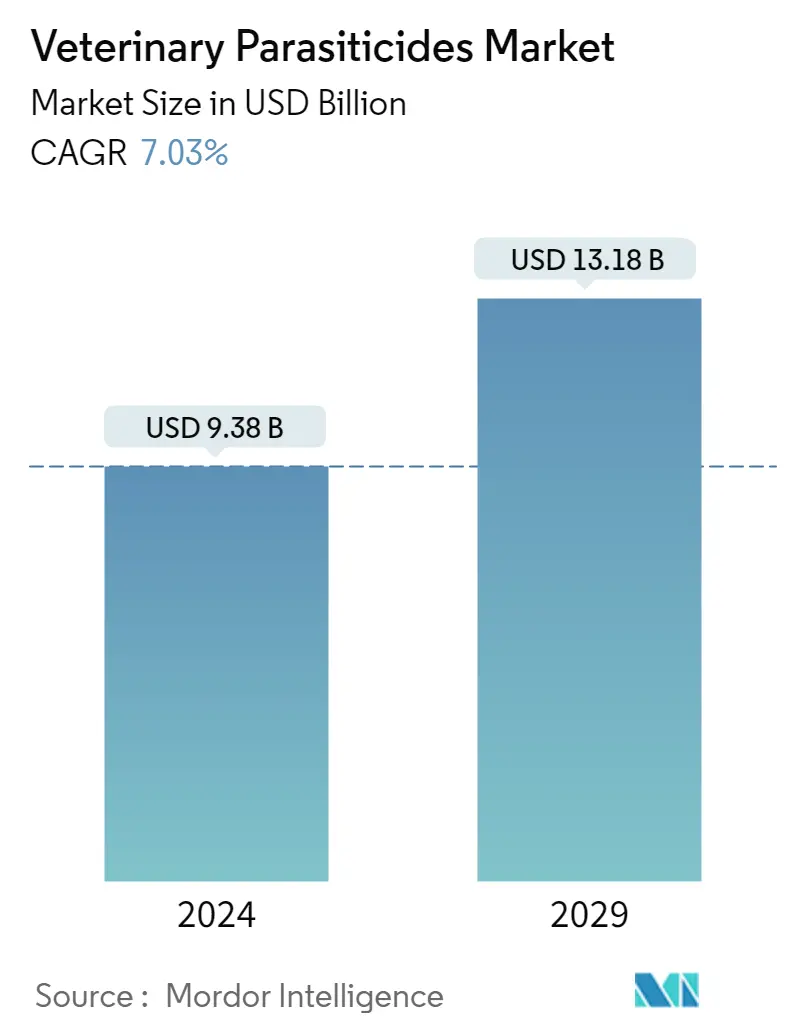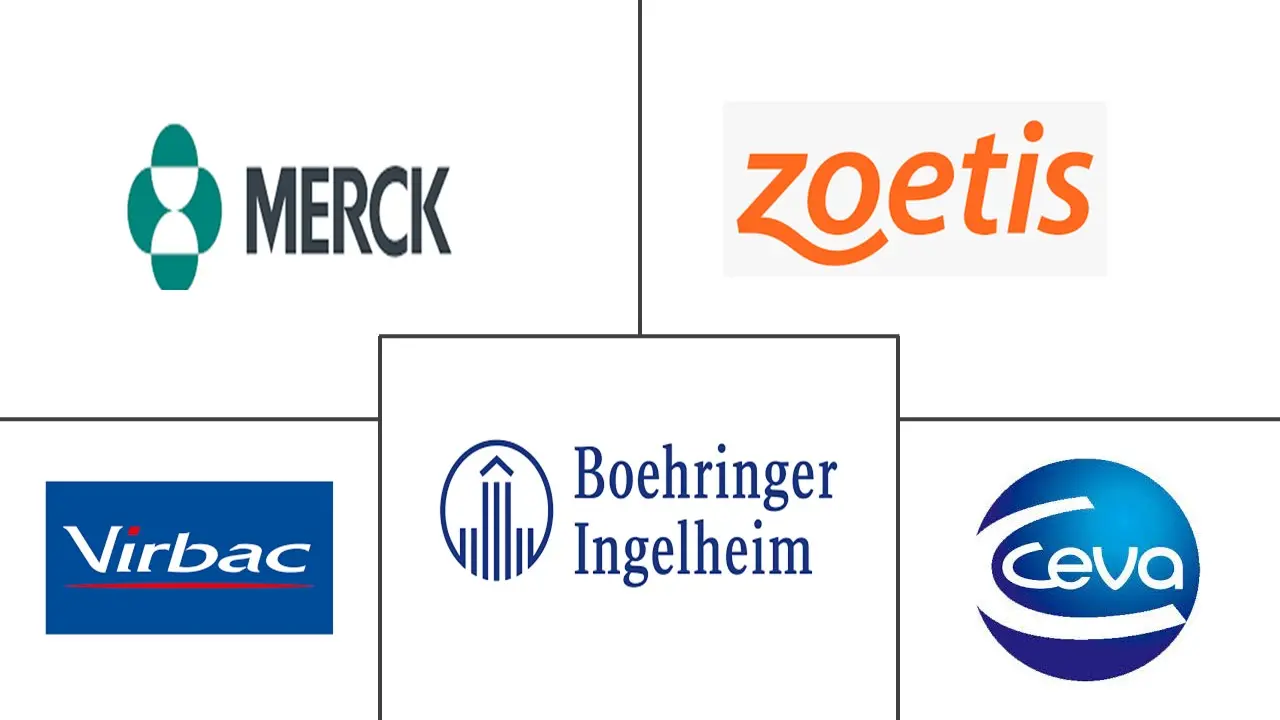Market Size of Veterinary Parasiticides Industry

| Study Period | 2019 - 2029 |
| Market Size (2024) | USD 9.38 Billion |
| Market Size (2029) | USD 13.18 Billion |
| CAGR (2024 - 2029) | 7.03 % |
| Fastest Growing Market | Asia-Pacific |
| Largest Market | Europe |
Major Players
*Disclaimer: Major Players sorted in no particular order |
Animal Parasiticides Market Analysis
The Veterinary Parasiticides Market size is estimated at USD 9.38 billion in 2024, and is expected to reach USD 13.18 billion by 2029, growing at a CAGR of 7.03% during the forecast period (2024-2029).
The COVID-19 pandemic reduced the demand for animal care. Due to infection control measures and statewide lockdowns, the pandemic impacted the number of visits to veterinary hospitals and clinics. According to the study published in the Indian Journal of Animal Science in June 2022, there was a significant difference in the number of cases attended during different lockdown periods and among veterinarians, with a decline in the number of cases heard across pet species (54.9%), followed by goats (35.3%), sheep (29.1%), cattle (25.5%), and buffalo (21.6%) during the lockdown. During the lockdown, veterinarian visits fell by 27.3%, while farmer visits to veterinary clinics fell by 61.9%. As a result, the market is expected to be disrupted during the pandemic due to decreased veterinary holidays and a lack of veterinary pharmaceuticals during the pandemic. However, since restrictions were removed, the industry recovered quickly. In coming years, a rise in veterinarian visits and the reopening of veterinary clinics are expected to drive the market's growth.
The veterinary parasiticides market will show rapid growth due to the rising zoonotic disease prevalence and transmission from pets and farm animals to humans and rising animal healthcare expenditure. According to the study published in the Infection Ecology & Epidemiology in September 2021, one of the most dangerous zoonotic diseases in the world is salmonellosis. Salmonella prevalence in animals and risk factors for increased transmission of salmonella spp. from animals to people were evident. In Spain, the prevalence of salmonella in dogs accounted for 1.85%. In China, 243 dogs were found to have a slightly higher prevalence of salmonella at 9.47%. Thus, a higher risk of these diseases in dogs is expected to increase the demand for treatment over the forecast period.
Moreover, the growing adoption of pets worldwide is likely to propel the market's growth over the forecast period. For instance, according to the People's Dispensary for Sick Animals (PDSA) PAW Report 2022, there were 10.2 million pet dogs, 11.1 million pet cats, and 1 million pet rabbits in the United Kingdom in 2022. The same source reported 52% of UK adults would own a pet in 2022. This rising adoption of pets is expected to drive the market's growth over the forecast period.
Thus, all the abovementioned factors are expected to propel the market's growth. However, the stringent regulatory policies for the approval of animal parasiticides and the high cost of animal parasiticide products are hindering the development of the veterinary parasiticides market.
Animal Parasiticides Industry Segmentation
As per the scope of the report, animal parasiticides or antiparasitics are chemical substances used to eradicate parasites that infect pets and other animals and subsequently improve animal health. Most finished parasiticides contain one or more active ingredients that help carry out a specific action against particular parasites. The veterinary parasiticides market is segmented by product type (ectoparasiticides, endoparasiticides, endectocides), animal type (food-producing animals, companion animals), and geography (North America, Europe, Asia-Pacific, Middle East and Africa, and South America). The market report also covers the estimated sizes and trends for 17 countries across major regions globally. The report offers the value (USD million) for the above segments.
| By Product Type | |
| Ectoparasiticides | |
| Endoparasiticides | |
| Endectocides |
| By Animal Type | |
| Food-producing Animals | |
| Companion Animals |
| By Geography | ||||||||
| ||||||||
| ||||||||
| ||||||||
| ||||||||
|
Veterinary Parasiticides Market Size Summary
The veterinary parasiticides market is poised for significant growth, driven by increasing zoonotic disease prevalence and rising animal healthcare expenditure. The market experienced a temporary setback during the COVID-19 pandemic due to reduced veterinary visits and disruptions in animal care. However, the industry has shown resilience and is expected to recover swiftly as veterinary clinics reopen and demand for animal care rises. The growing adoption of pets worldwide further propels market expansion, as pet owners increasingly seek effective parasitic treatments to safeguard their animals' health. Despite challenges such as stringent regulatory policies and high product costs, the market is anticipated to grow, particularly in the companion animal segment, where pet owners are willing to invest more in premium and ethically sourced products.
North America currently leads the veterinary parasiticides market, with the United States maintaining a substantial share due to high pet ownership and increased spending on animal healthcare. The trend of pet adoption is also rising in other regions, such as Canada and Mexico, contributing to the market's growth. Major players in the industry are actively engaging in strategic initiatives, including mergers and acquisitions, to expand their geographic presence and enhance their product offerings. The competitive landscape is characterized by key players like Elanco Animal Health, Boehringer Ingelheim, and Zoetis Inc., who are continuously innovating and expanding their portfolios to meet the growing demand for veterinary parasiticides.
Veterinary Parasiticides Market Size - Table of Contents
-
1. MARKET DYNAMICS
-
1.1 Market Overview
-
1.2 Market Drivers
-
1.2.1 Rising Prevalence of Food Borne and Zoonotic Diseases
-
1.2.2 Growing Adoption of Pet Animals
-
1.2.3 Rising Animal Health Expenditure
-
-
1.3 Market Restraints
-
1.3.1 Stringent Approval Process for Animal Parasiticides
-
1.3.2 High Cost of Animal Parasiticide Products
-
-
1.4 Porter's Five Forces Analysis
-
1.4.1 Threat of New Entrants
-
1.4.2 Bargaining Power of Buyers/Consumers
-
1.4.3 Bargaining Power of Suppliers
-
1.4.4 Threat of Substitute Products
-
1.4.5 Intensity of Competitive Rivalry
-
-
-
2. MARKET SEGMENTATION (Market Size by Value - USD million)
-
2.1 By Product Type
-
2.1.1 Ectoparasiticides
-
2.1.2 Endoparasiticides
-
2.1.3 Endectocides
-
-
2.2 By Animal Type
-
2.2.1 Food-producing Animals
-
2.2.2 Companion Animals
-
-
2.3 By Geography
-
2.3.1 North America
-
2.3.1.1 United States
-
2.3.1.2 Canada
-
2.3.1.3 Mexico
-
-
2.3.2 Europe
-
2.3.2.1 Germany
-
2.3.2.2 United Kingdom
-
2.3.2.3 France
-
2.3.2.4 Italy
-
2.3.2.5 Spain
-
2.3.2.6 Rest of Europe
-
-
2.3.3 Asia-Pacific
-
2.3.3.1 China
-
2.3.3.2 Japan
-
2.3.3.3 India
-
2.3.3.4 Australia
-
2.3.3.5 South Korea
-
2.3.3.6 Rest of Asia-Pacific
-
-
2.3.4 Middle East and Africa
-
2.3.4.1 GCC
-
2.3.4.2 South Africa
-
2.3.4.3 Rest of Middle East and Africa
-
-
2.3.5 South America
-
2.3.5.1 Brazil
-
2.3.5.2 Argentina
-
2.3.5.3 Rest of South America
-
-
-
Veterinary Parasiticides Market Size FAQs
How big is the Veterinary Parasiticides Market?
The Veterinary Parasiticides Market size is expected to reach USD 9.38 billion in 2024 and grow at a CAGR of 7.03% to reach USD 13.18 billion by 2029.
What is the current Veterinary Parasiticides Market size?
In 2024, the Veterinary Parasiticides Market size is expected to reach USD 9.38 billion.

